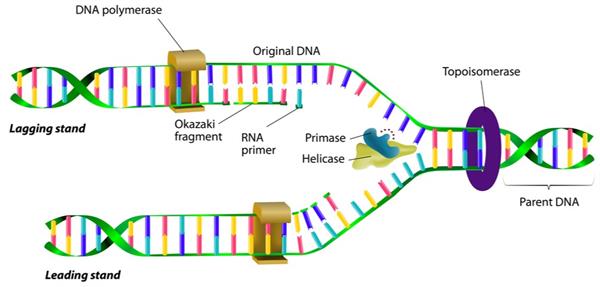
PUMPA - SMART LEARNING
எங்கள் ஆசிரியர்களுடன் 1-ஆன்-1 ஆலோசனை நேரத்தைப் பெறுங்கள். டாப்பர் ஆவதற்கு நாங்கள் பயிற்சி அளிப்போம்
Book Free DemoEvery day in our human body, \(50\) to \(60\) billion cells dies. This phenomenon of cell death is a normal cycle, called programmed cell death or apoptosis. To maintain the balance of the lost cells in our body, billion of cells undergo the cycle - cell division. This process of cell division is called mitosis. Copying DNA is one of the first steps of cell division.
DNA replication is one of the essential processes in a cell. During the replication process, the DNA molecule creates exact copies of its structure. The nucleotides of each strand provide the information needed to produce its new strand, and the two strands of a DNA molecule have complementary base pairs. The two daughter cells that result have identical genetic information as the parent cell.
The steps involved in DNA replication are as follows:

DNA replication
Origin of replication
The site of origin of replication is the specific point on the DNA where replication begins. At this point, the two strands open and separate, generating the replication fork.
An unwinding of DNA molecule
The helicase enzyme binds to the replication site's origin. Helicase is an enzyme that separates the two strands of DNA. Topoisomerase is an enzyme that unwinds the double helix above the replication fork and eliminates the twists throughout the process. The separated DNA strands each act as a template.
Formation of RNA primer
An RNA primer is a short RNA nucleotide segment. The primer is made by the DNA template close to the replication site's origin.
Synthesis of a new complementary strand from the parent strand
After the RNA primer is created, nucleotides are added using the enzyme DNA polymerase, and a new complementary strand of DNA is created from each parent strand. It is a unidirectional (one-way) synthesis.
In one strand, the daughter strand is synthesised as a continuous strand known as the leading strand. Short DNA fragments are produced on the other strand, which is referred to as the lagging strand. Okazaki fragments are the short segments of deoxyribonucleotides, which are formed at the lagging strand during replication. These DNA fragments are linked by the enzyme called ligase.
Replication comes to a stop when the replication forks on both sides meet at a location known as the terminus, which is located opposite the replication site's origin.
Significance of DNA
- DNA is the genetic material that allows genetic information to be passed down from one generation to the next.
- The information contained in DNA is necessary for the formation of proteins.
- DNA controls an organism's developmental process and life activities.